CAN we get away with a single break crop if we throw enough ‘aggressive agronomy’ at a ryegrass population? Are expensive herbicides worth the money? What is better, disc or tyne? Why were the batsmen tampering with the ball, shouldn’t that be the bowler’s job?
These are all questions that were being asked by a local project committee of growers and advisers, and there was only one way to answer them. Enter Tony Swan from CSIRO.
He and his team embarked on a massive, long-term research effort in Temora, NSW, working with FarmLink Research to make it happen. The trial ran from 2014 to 2017 and the preliminary results are in.
And the winner is…DIVERSITY
Diverse crop rotations, including a double break, premium herbicides, with some extra crop competition courtesy of barley thrown in, and we have a winner. This diverse crop rotation smashed ryegrass numbers down from 1864 plants/square metre to 145 plants/m2 in just three years, and it was also the most profitable rotation.
More crop, fewer weeds, more profit.
While four of the ‘Weedsmart Big 6’ tools were used to achieve this, Tony reckons ryegrass numbers would have been obliterated if they could have used the other two strategies – crop topping and harvest weed seed control – in their trial plots.
At the other end of the scale, the conservative rotation with a single break crop, low-cost herbicides and low crop competition saw a blowout in ryegrass numbers and reduced profit.
Undaunted by the ‘disc or tyne’ challenge posed by the committee, Tony and his team sowed each rotation with both seeding systems each year. A fantastic achievement, but essentially there wasn’t much in it – suggesting that there are bigger fish to fry when it comes to weed management.
The finer details
In a previous AHRI Insight, we highlighted research by Tony Swan and the team from CSIRO that showed double breaks (i.e. growing two break crops in sequence) were more effective in reducing annual ryegrass numbers than a single break crop or continuous wheat.
The research team took this one step further in a project involving FarmLink in southern NSW from 2014-2017, comparing three rotation strategies between disc and tyne seeding systems in a stubble retained system and their impact on ryegrass, yield and profitability.
The table below summarises the farming systems that were compared in this gruelling four-year trial.
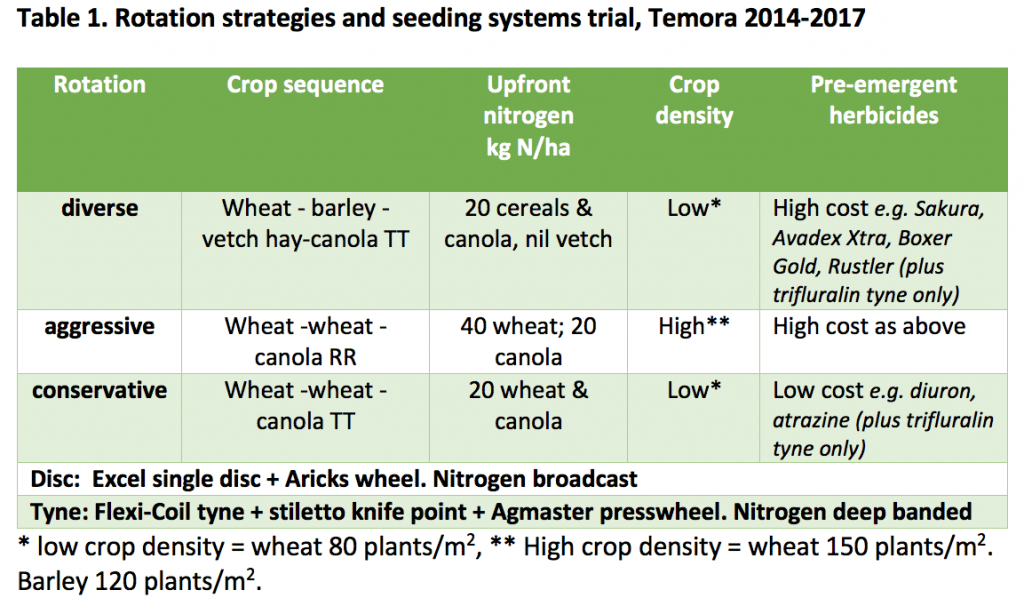 Diversity beats ryegrass. Again!
Diversity beats ryegrass. Again!
The ‘diverse’ rotation had a few things going for it:
- Double break of vetch for hay followed by canola;
- A competitive barley crop that held the weeds at bay in the long, wet 2016 season after the pre-em herbicides ran out of puff; and
- Mixing and rotating high cost, premium herbicides.
This combination reduced the ryegrass seedbank by 70 per cent, compared with a single break aggressive rotation of wheat-wheat-canola. Where low-cost herbicides were used in the conservative rotation, things got a bit ugly, with ryegrass numbers in the wheat-wheat-canola rotation blowing out by 600pc (Figure 1).
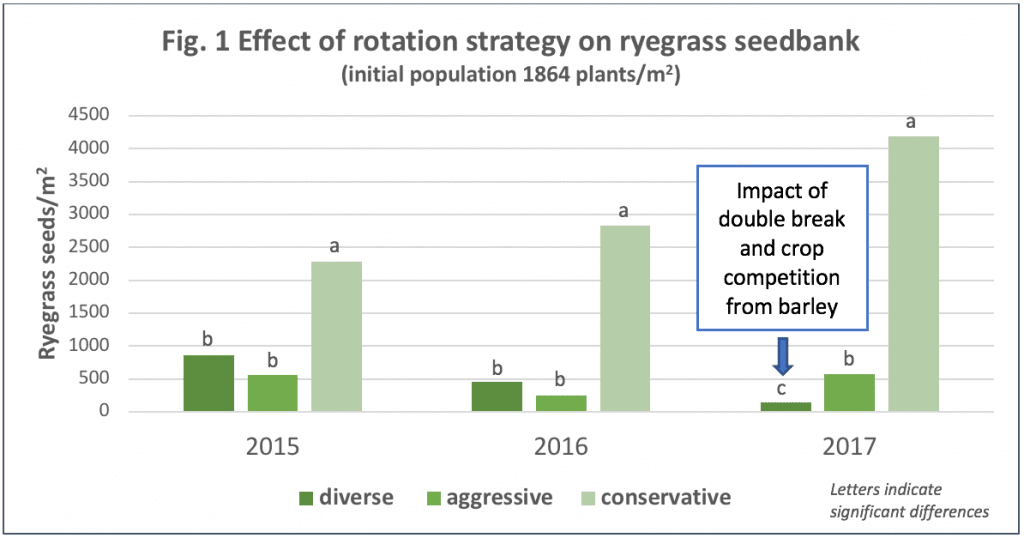 Disc vs tyne
Disc vs tyne
There wasn’t much difference in ryegrass numbers between the disc and tyne systems where premium pre-emergent herbicides were used in the ‘diverse’ and ‘aggressive’ rotations (Table 2). The tyne system had the edge over the disc following the very wet 2016 season, but keep in mind that the disc system didn’t have the benefit of trifluralin application (Figure 2).
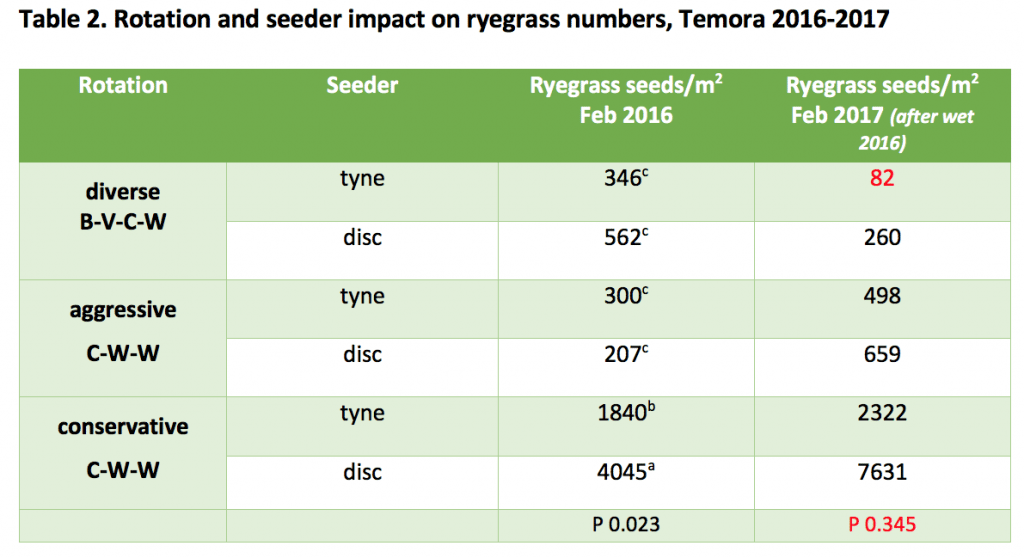 Ryegrass numbers did blow out for the disc system where low-cost herbicides were used in the ‘conservative’ rotation. This comes as no surprise as herbicide options were limited for the disc seeder in this treatment and don’t reflect recommended agronomy for high ryegrass populations.
Ryegrass numbers did blow out for the disc system where low-cost herbicides were used in the ‘conservative’ rotation. This comes as no surprise as herbicide options were limited for the disc seeder in this treatment and don’t reflect recommended agronomy for high ryegrass populations.
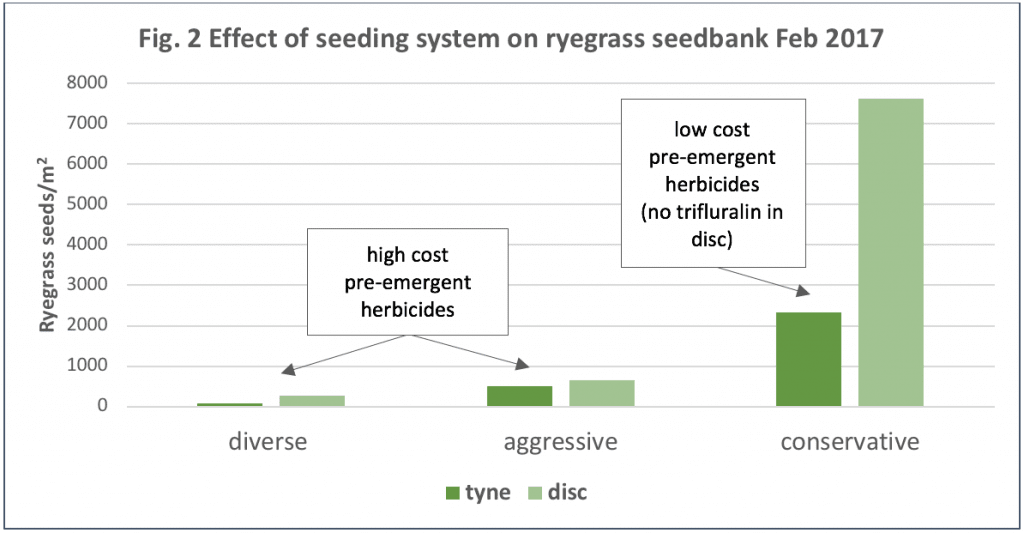 Crop yields and profitability
Crop yields and profitability
Profitability over four years was highest for the ‘diverse’ rotation. This was primarily driven by lower nitrogen costs, but also due to higher yields from barley compared with a second wheat crop in the other rotations. As noted by the project team, the diverse rotation also allowed crops to be sown into less antagonistic stubbles for improved emergence and disease management in a stubble retained system (e.g. avoiding canola sown into cereal stubble or wheat sown on wheat stubble).
There were no yield differences over four years between disc and tyne systems where weeds were managed in the ‘diverse’ and ‘aggressive’ rotations. In the ‘conservative’ rotation with low-cost pre-emergent herbicides, yields were higher in the tyne system where ryegrass numbers could be managed with the addition of trifluralin.
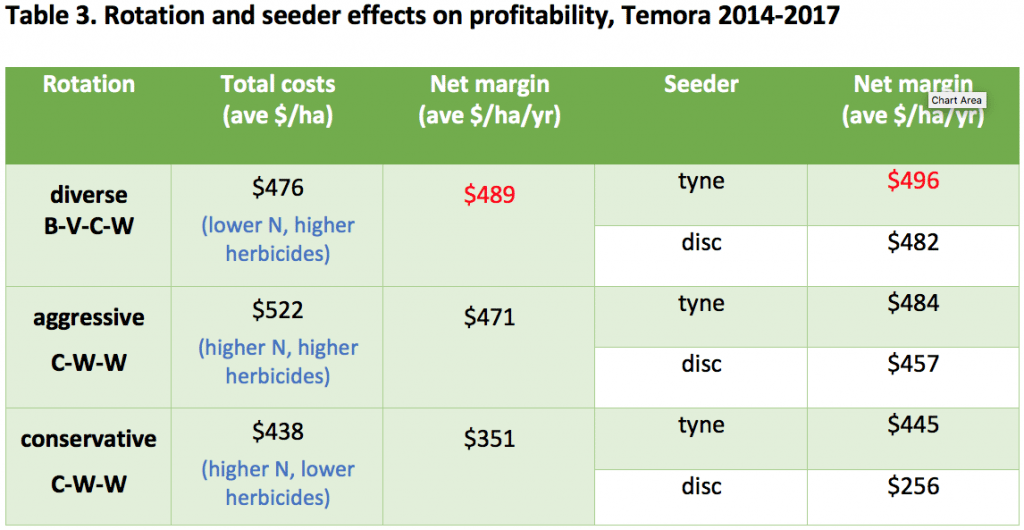 Summary
Summary
Long-term trials such as this one are fantastic and they generate a lot of data. This can make it hard to work out exactly what happened, so here’s a snapshot of what we can learn from this excellent research:
- Double breaks are great for weeds and profit;
- Crop competition from a crop like barley can be a major benefit, particularly in a long, wet season;
- The premium herbicides are worth the money (in a high yielding environment) – Mix and Rotate;
- There is not much difference between disc and tyne systems where premium herbicides are used;
- Weeds hate diversity; and
- It never pays to tamper with the cricket ball!
Further reading
Read A flexible approach to managing stubble profitably in the Riverina and Southwest Slopes of NSW by Tony Swan.
Acknowledgements
This research was funded by GRDC.
Source: AHRI Insight 98: https://ahri.uwa.edu.au/what-matters-more-crop-sequence-or-seeder/
Grain Central: Get our free daily cropping news straight to your inbox – Click here

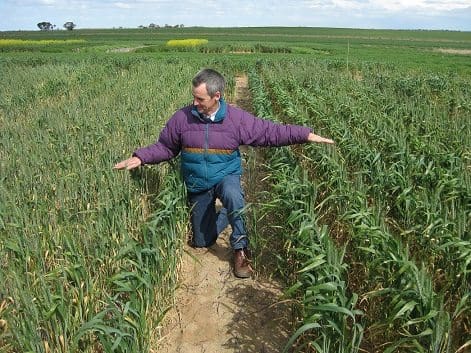


HAVE YOUR SAY